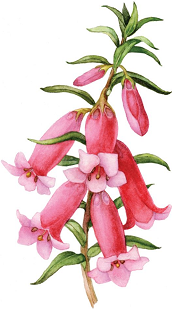Drought Tolerant Native Plants
Many Australian native plants thrive in hot, arid conditions. They often have very colourful flowers, colourful foliage, a habit of growth which makes them well suited for garden use, and grow well in Melbourne’s climate without supplementary watering.
Recommended plants
This selection of plants is suited to climates and soils similar to Melbourne. Once established (Ie after two years) they are drought tolerant.
Before making a selection take into account your local climate and soils as some plants may require alkaline soil or are unsuitable for coastal, humid, wet or alpine conditions. It is recommended you seek advice from your local APS District group or an experienced local nurseryman.
Acacia willdenowiana (Grass Wattle)
Alyogyne hakeifolia
Banksia hookeriana
Banksia media
Beaufortia orbifolia (Ravensthorpe Bottlebrush)
Callistemon ‘Kings Park Special’
Calocephalus citreus (Lemon Beauty Heads)
Calothamnus quadrifidus [grey leaf form] (Common Net-bush)
Chamelaucium uncinatum (Geraldton Wax)
Chrysocephalum apiculatum (Common Everlasting)
Correa backhouseana [Kangaroo Island form]
Correa glabra
Correa pulchella [white flower form]
Correa reflexa [Little Desert form] (Common Correa)
Daviesia ulicifolia (Gorse Bitter-pea)
Dodonaea boroniifolia (Fern-leaf Hop-bush)
Dryandra praemorsa (Cut-leaf Dryandra)
Eremophila abietina (Spotted Poverty-bush)
Eremophila duttonii
Eremophila glabra (Common Emu-bush)
Eremophila maculata ssp brevifolia
Eremophila mirabilis
Eremophila psilocalyx
Eremophila purpurascens x alternifolia
Eucalyptus albopurpurea [purple flowers]
Eucalyptus eremophila (Tall Sand Mallee)
Eucalyptus erythrocorys (Illyarrie or Red-cap Gum)
Eucalyptus pyriformis (Pear-fruited Mallee)
Eucalyptus sideroxylon
Eucalyptus websteriana (Webster’s Mallee)
Eucalyptus woodwardii (Lemon-flowered Gum)
Gossypium sturtianum (Sturt’s Desert Rose)
Grevillea aspera
Grevillea cagiana (Gardner’s Grevillea)
Grevillea juncifolia (Honeysuckle Grevillea)
Grevillea kennedyana (Flame Spider-flower)
Grevillea pilosa
Grevillea steiglitziana (Brisbane Ranges Grevillea)
Grevillea thyrsoides
Hakea (Burrendong Beauty)
Hakea francisiana (Narukalja)
Hakea invaginata
Hakea neurophylla
Hakea orthorrhyncha
Isopogon formosus (Rose Cone-flower)
Kunzea pulchella
Lomandra confertifolia
Macrozamia species (Zamia)
Maireana sedifolia (Pearl Bluebush)
Melaleuca elliptica (Granite Honey-myrtle)
Myoporum floribundum (Slender Myoporum)
Olearia passerinoides (Daisy Bush)
Prostanthera nivea (Snowy Mint-bush)
Santalum acuminatum (Quandong)
Senna species
Templetonia species
Verticordia grandis
Xanthorrhoea species (Grass Tree)
How to Spot a Drought Tolerant Plant
Confronted with the large selection of plants in most nurseries here are features which point to those most likely to be drought tolerant. They evolved through natural selection to maximise the plant’s chances of survival by protecting it from the effects of hot sun, allowing it to store water for times of drought, and reducing water loss from the plant to the atmosphere.
Silver leaves
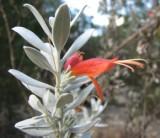
Eremophila glabra
Common Emu-bush
(grey-leaf form)
Reflect sunlight keeping the leaf cool and minimising water loss through the pores.
A covering of fine hairs, which partially shades and restricts air flow close to the leaf’s surface, further reducing water loss, may be present. These hairs may absorb dew and moisture from the atmosphere, allowing the plant to supplement water it receives from rainfall.
Thick waxy coating on the leaves
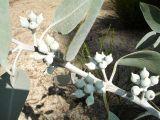
Eucalyptus woodwardii
Lemon-flowered Gum
Forms a barrier reducing water loss.
May be accompanied by a powdery coating which restricts air flow close to the surface of the leaf further reducing water loss
Very small leaves

Callitris rhomboidea
Oyster Bay Pine
The smaller the leaf the smaller its surface area and the number of pores through which water can be lost by the plant to the atmoshpere.
Presence of phyllodes instead of leaves
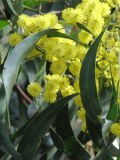
Acacia pycnantha
Golden Wattle
Phyllode = flattened leafstalk that functions like a leaf.
Most native Acacia species develop phyllodes .
Minimise water loss because they are usually thick, leathery and vertically orientated to minimise the amount of sunlight falling on them on hot summer days when the sun is high in the sky.
Thick, fleshy leaves or stems
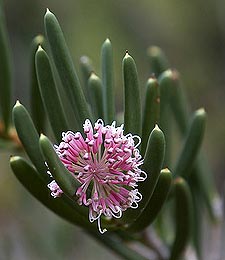
Hakea clavata
Coast Hakea
Plants with thick, fleshy leaves or stems which retain water for times of drought are called succulents.
They have a characteristic swollen or fleshy appearance known as succulence.
Tubers and enlarged roots

Pelargonium rodneyanum
Magenta Stork’s Bill
Act as a food and water store.
The plant draws on these reserves to survive during drought and to regrow if the above ground parts of the plant are destroyed by fire or grazing animals.
Presence of a lignotuber

Eucalyptus rossii
Scribbly Gum
Note the large lignotuber
Lignotuber = woody swelling at or just below ground level.
Food store for hard times and the site of regenerative buds from which new stems form if the above-ground parts of the plant are destroyed.
Enlarged Water-storing Trunk
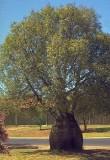
Brachychiton rupestris
Queensland Bottle Tree
Examples of large stem succulents.
Native trees with this characteristic include Brachychiton rupestris (Bottle tree), Brachychiton populneus (Kurrajong), Brachychiton acerifolius (Illawarra Flame Tree) and other Brachychiton species.
Yellow roots
Some nurserymen specialising in drought tolerant plants have noticed that plants with yellow roots seem to be more drought resistant than other plants. The reason for this is not known.
